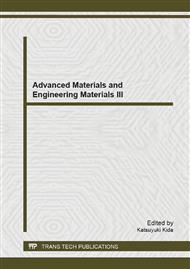p.488
p.492
p.496
p.500
p.504
p.508
p.512
p.519
p.524
Design and Manufacturing Bio Composite (Sugarcane Bagasse – Polyvinyl Acetate) Panel that Characterized Thermal Conductivity
Abstract:
The use of sugarcane bagasse for providing avaibility of raw material have been attracting attention. The benefits using natural fiber such as sugarcane bagasse are eco-friendly, low cost considerations because widespread avaibility, high stiffness, better thermal stability, and biodegradability. Sugarcane bagasse and (Polyvinyl acetate, PVAc) have been shown to possess the ability of being applied as raw material for manufacturing of bio composite panel at 10mm thickness (fixed variable) by three mesh sizes (20,30 dan 40) with ratio of the composition 95:5, 90:10 and 85:15%. The specimen have been emphasized at 3:2 and 2:1. This research was conducted to investigate possibility of manufacturing bio composite panel that its characteristic resistance to the thermal conductivity. This bio composite speciments were tested for thermal conductivity test according to ASTM E-1225. The results revealed that optimum design for bio composite panel obtained that emphasis at 3:2, filtered by mesh size 20, ratio composition sugarcane bagasse 85% and PVAc 15%. The test result shown that panel has thermal conductivity resistance value (R) 17,089 °C/W. Thus, it can be concluded that bio composite panel can be manufactured successfully from sugarcane bagasse and PVAc as the matrix mixture.
Info:
Periodical:
Pages:
504-507
Citation:
Online since:
February 2014
Keywords:
Price:
Сopyright:
© 2014 Trans Tech Publications Ltd. All Rights Reserved
Share:
Citation:


